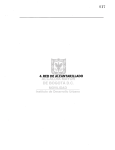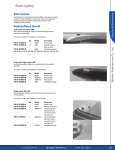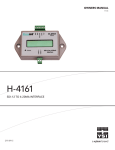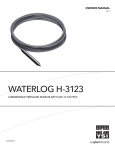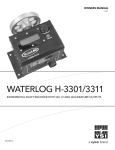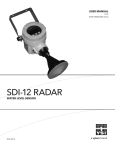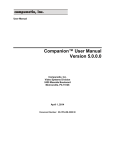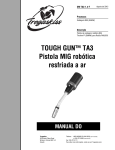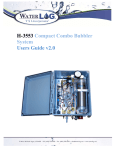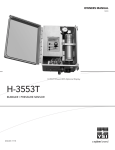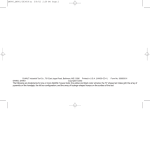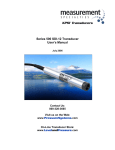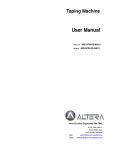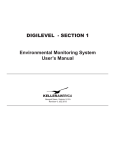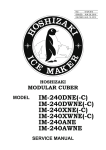Download P:\Waterlog\H352-1(Fluid)\Manual\User Manual v15\MasterDoc
Transcript
Model H-3521 Liquid & Gas Compatible Pressure Sensor with SDI-12, 4-20mA and Modbus Outputs Owner's Manual Version 1.5 D E S I G N 75 West 100 South, Logan, Utah 84321 A N A L Y S I S Phone: (435) 753-2212 A S S O C I A T E S , Fax: (435) 753-7669 I N C. Web: http://www.waterlog.com E-mail: [email protected] User Agreement/ WATERLOG® Warranty 1. NATURE OF THE PRODUCT This agreement accompanies a pressure measuring system comprising firmware, circuitry and other electronic equipment in an enclosed housing, and packaged together with written instructional materials. The packaged electronic circuitry and instructional materials herein are collectively referred to as the “PRODUCT.” The PRODUCT is made available from DESIGN ANALYSIS ASSOCIATES, INC., of 75 West 100 South, Logan, Utah 84321 (hereinafter referred to as “DESIGN ANALYSIS”), and contains information and embodies technology that is confidential and proprietary to DESIGN ANALYSIS, and the availability and use of the PRODUCT is extended to you, the USER, solely on the basis of the terms of agreement which follow. 2. ACKNOWLEDGMENTS BY USER Opening the package which encloses the accompanying PRODUCT indicates your acceptance of the terms and conditions of this agreement and constitutes an acknowledgment by you of the confidential and proprietary nature of the rights of DESIGN ANALYSIS in the PRODUCT. 3. DUTIES OF YOU, THE USER In consideration for the access to and use of the PRODUCT extended to you by DESIGN ANALYSIS and to protect the confidential and proprietary information of DESIGN ANALYSIS, USER agrees as follows: (a) USER agrees that they will not remove from the exterior of the housing of the PRODUCT any safety warnings or notices of proprietary interest placed thereon by DESIGN ANALYSIS. (b) USER agrees that they shall not disassemble or otherwise reverse engineer the PRODUCT. (c) USER agrees to treat the PRODUCT with the same degree of care as USER exercises in relation to their own confidential and proprietary information. 4. TERM USER may enjoy these rights only as long as their possession of the PRODUCT shall continue to be rightful. These rights will cease if the PRODUCT is returned to DESIGN ANALYSIS under the terms of any redemption offer, warranty, or money-back guarantee, or if USER transfers the PRODUCT to another party on terms inconsistent with this agreement. 5. LIMITED WARRANTY (a) What is Covered DESIGN ANALYSIS warrants that for a period of twelve months from the time of delivery the functions to be performed by the PRODUCT will be substantially in compliance with USER documentation. DESIGN ANALYSIS also warrants that the PRODUCT will be free from defects in materials and workmanship for a period of ONE YEAR from the date of delivery. (b) What USER Must Do H-3521 User Agreement/WATERLOG® Warranty W-1 If the product fails to satisfy the above warranty, USER must notify DESIGN ANALYSIS in writing within the applicable period specified above and reasonably cooperate with the directions they received from DESIGN ANALYSIS. (c) What DESIGN ANALYSIS Will Do DESIGN ANALYSIS will repair the PRODUCT or will endeavor to provide a replacement of same within a reasonable period of time. In the event that DESIGN ANALYSIS is unable to make the necessary repairs or replacement within a reasonable period of time, the original purchase price will be refunded upon the return of the PRODUCT to DESIGN ANALYSIS. (d) Limitations (i) THE ENTIRE REMEDY FOR BREACH OF THIS LIMITED WARRANTY SHALL BE LIMITED TO REPLACEMENT OF THE DEFECTIVE PRODUCT OR REFUNDING OF THE PURCHASE PRICE, AS SET FORTH ABOVE. IN NO EVENT WILL THE LIABILITY OF DESIGN ANALYSIS TO USER OR TO ANY OTHER PARTY EXCEED THE ORIGINAL PURCHASE PRICE OF THE PRODUCT, REGARDLESS OF THE FORM OF THE CLAIM. (ii) EXCEPT FOR THE EXPRESS WARRANTIES ABOVE, DESIGN ANALYSIS SPECIFICALLY DISCLAIMS ALL OTHER WARRANTIES, INCLUDING, WITHOUT LIMITATION, ALL IMPLIED WARRANTIES OF MERCHANTABILITY AND FITNESS FOR A PARTICULAR PURPOSE. (iii) UNDER NO CIRCUMSTANCES WILL DESIGN ANALYSIS BE LIABLE FOR SPECIAL, INCIDENTAL, CONSEQUENTIAL, INDIRECT, OR ANY OTHER DAMAGES OR CLAIMS ARISING FROM THE USE OF THIS PRODUCT, THIS INCLUDES LOSS OF PROFITS OR ANY OTHER COMMERCIAL DAMAGES, EVEN IF ADVISED OF THE POSSIBILITY OF SUCH DAMAGES. IN NO EVENT WILL DESIGN ANALYSIS BE LIABLE FOR ANY CLAIMS, LIABILITY, OR DAMAGES ARISING FROM MODIFICATION MADE THEREIN, OTHER THAN BY DESIGN ANALYSIS. (iv) THIS LIMITED WARRANTY GIVES USER SPECIFIC LEGAL RIGHTS. USER MAY ALSO HAVE OTHER RIGHTS WHICH VARY FROM STATE TO STATE. SOME STATES DO NOT ALLOW LIMITATIONS ON HOW LONG AN IMPLIED WARRANTY LASTS OR THE EXCLUSION OF INCIDENTAL OR CONSEQUENTIAL DAMAGES, SO THOSE LIMITATIONS OR EXCLUSIONS MAY NOT APPLY. 6. GOVERNING LAW This Agreement and its validity and interpretation shall be governed by the laws of the State of Utah, notwithstanding any choice of law rules of Utah or any other state or jurisdiction. W-2 User Agreement/WATERLOG® Warranty H-3521 Table of Contents ® User Agreement/WATERLOG Warranty . . . . . . . . . . . . . . . . . . . . . . . . . . . . . . . . . . . . . . . . W-1 Chapter 1 Introduction 1.0 Introduction . . . . . . . . . . . . . . . . . . . . . . . . . . . . . . . . . . . . . . . . . . . . . . . . . . . . . . . . . . . . 1-1 1.1 Unpacking . . . . . . . . . . . . . . . . . . . . . . . . . . . . . . . . . . . . . . . . . . . . . . . . . . . . . . . . . . . . . . 1-2 1.2 Check The Model Number . . . . . . . . . . . . . . . . . . . . . . . . . . . . . . . . . . . . . . . . . . . . . . . . . 1-2 Chapter 2 Installation 2.1 Installing the WATERLOG® H-3521 Fluid . . . . . . . . . . . . . . . . . . . . . . . . . . . . . . . . . . . . . . 2.2 Water Depth . . . . . . . . . . . . . . . . . . . . . . . . . . . . . . . . . . . . . . . . . . . . . . . . . . . . . . . . . . . . 2.3 General Installation Recommendations . . . . . . . . . . . . . . . . . . . . . . . . . . . . . . . . . . . . . . . 2.4 Instrument Shelter . . . . . . . . . . . . . . . . . . . . . . . . . . . . . . . . . . . . . . . . . . . . . . . . . . . . . . . . 2.5 Making Connections to the Pressure Port . . . . . . . . . . . . . . . . . . . . . . . . . . . . . . . . . . . . . . 2.6 Connecting Your Data Logger . . . . . . . . . . . . . . . . . . . . . . . . . . . . . . . . . . . . . . . . . . . . . . . 2.6.1 SDI-12 Interface . . . . . . . . . . . . . . . . . . . . . . . . . . . . . . . . . . . . . . . . . . . . . . . . . . 2.6.2 RS-232 Output . . . . . . . . . . . . . . . . . . . . . . . . . . . . . . . . . . . . . . . . . . . . . . . . . . . 2.6.3 4-20mA Output . . . . . . . . . . . . . . . . . . . . . . . . . . . . . . . . . . . . . . . . . . . . . . . . . . 2.6.4 Modbus Interface . . . . . . . . . . . . . . . . . . . . . . . . . . . . . . . . . . . . . . . . . . . . . . . . . 2.7 Wiring and Installation Precautions . . . . . . . . . . . . . . . . . . . . . . . . . . . . . . . . . . . . . . . . . . 2.8 Programming Your SDI-12 Data Recorder . . . . . . . . . . . . . . . . . . . . . . . . . . . . . . . . . . . . . 2.9 Programming the SDI-12 Address . . . . . . . . . . . . . . . . . . . . . . . . . . . . . . . . . . . . . . . . . . . 2.10 Programming the H-3521 Fluid Sensor . . . . . . . . . . . . . . . . . . . . . . . . . . . . . . . . . . . . . . 2.10.1 Setting the Stage . . . . . . . . . . . . . . . . . . . . . . . . . . . . . . . . . . . . . . . . . . . . . . . . 2.10.2 4-20mA Output . . . . . . . . . . . . . . . . . . . . . . . . . . . . . . . . . . . . . . . . . . . . . . . . . . 2.10.3 Programming the 4-20mA Output Range . . . . . . . . . . . . . . . . . . . . . . . . . . . . . 2.11 Testing . . . . . . . . . . . . . . . . . . . . . . . . . . . . . . . . . . . . . . . . . . . . . . . . . . . . . . . . . . . . . . . . 2-1 2-1 2-2 2-2 2-3 2-4 2-5 2-5 2-5 2-5 2-6 2-6 2-6 2-6 2-7 2-8 2-8 2-9 Chapter 3 Maintenance/Troubleshooting 3.1 Maintenance . . . . . . . . . . . . . . . . . . . . . . . . . . . . . . . . . . . . . . . . . . . . . . . . . . . . . . . . . . . . 3.2 Precautions . . . . . . . . . . . . . . . . . . . . . . . . . . . . . . . . . . . . . . . . . . . . . . . . . . . . . . . . . . . . . 3.3 Offset Drift . . . . . . . . . . . . . . . . . . . . . . . . . . . . . . . . . . . . . . . . . . . . . . . . . . . . . . . . . . . . . 3.4 Troubleshooting . . . . . . . . . . . . . . . . . . . . . . . . . . . . . . . . . . . . . . . . . . . . . . . . . . . . . . . . . 3-1 3-1 3-1 3-1 Chapter 4 Simple Menu Interface 4.0 Simple Menu Interface . . . . . . . . . . . . . . . . . . . . . . . . . . . . . . . . . . . . . . . . . . . . . . . . . . . . 4.1 Connecting to the H-3521 Fluid . . . . . . . . . . . . . . . . . . . . . . . . . . . . . . . . . . . . . . . . . . . . . 4.2 General Operations . . . . . . . . . . . . . . . . . . . . . . . . . . . . . . . . . . . . . . . . . . . . . . . . . . . . . . . 4.3 Menu Options . . . . . . . . . . . . . . . . . . . . . . . . . . . . . . . . . . . . . . . . . . . . . . . . . . . . . . . . . . . 4.3.1 P - Sensor Mode Options . . . . . . . . . . . . . . . . . . . . . . . . . . . . . . . . . . . . . . . . . . . 4.3.2 V - Sensor Output Options . . . . . . . . . . . . . . . . . . . . . . . . . . . . . . . . . . . . . . . . . . 4.3.3 A - SDI-12 Address . . . . . . . . . . . . . . . . . . . . . . . . . . . . . . . . . . . . . . . . . . . . . . . 4.3.4 S - Stage . . . . . . . . . . . . . . . . . . . . . . . . . . . . . . . . . . . . . . . . . . . . . . . . . . . . . . . . 4.3.5 D - Digits . . . . . . . . . . . . . . . . . . . . . . . . . . . . . . . . . . . . . . . . . . . . . . . . . . . . . . . 4-1 4-1 4-2 4-3 4-3 4-3 4-3 4-3 4-3 H-3521 Table of Contents T-1 4.3.6 O - Offset . . . . . . . . . . . . . . . . . . . . . . . . . . . . . . . . . . . . . . . . . . . . . . . . . . . . . . . 4.3.7 U - Slope . . . . . . . . . . . . . . . . . . . . . . . . . . . . . . . . . . . . . . . . . . . . . . . . . . . . . . . 4.3.8 C - Averaged Measurements . . . . . . . . . . . . . . . . . . . . . . . . . . . . . . . . . . . . . . . . 4.3.9 M - Measure . . . . . . . . . . . . . . . . . . . . . . . . . . . . . . . . . . . . . . . . . . . . . . . . . . . . . 4.3.10 X - Exit . . . . . . . . . . . . . . . . . . . . . . . . . . . . . . . . . . . . . . . . . . . . . . . . . . . . . . . . 4.4 Sensor Mode Options Menu . . . . . . . . . . . . . . . . . . . . . . . . . . . . . . . . . . . . . . . . . . . . . . . . 4.4.1 P - Power Mode . . . . . . . . . . . . . . . . . . . . . . . . . . . . . . . . . . . . . . . . . . . . . . . . . . 4.4.2 F - Fast Mode . . . . . . . . . . . . . . . . . . . . . . . . . . . . . . . . . . . . . . . . . . . . . . . . . . . . 4.4.3 N - NOAA Mode . . . . . . . . . . . . . . . . . . . . . . . . . . . . . . . . . . . . . . . . . . . . . . . . . 4.4.4 R - Measure Rate . . . . . . . . . . . . . . . . . . . . . . . . . . . . . . . . . . . . . . . . . . . . . . . . . 4.4.5 D - Reset to Defaults . . . . . . . . . . . . . . . . . . . . . . . . . . . . . . . . . . . . . . . . . . . . . . 4.5 Sensor Output Options Menu . . . . . . . . . . . . . . . . . . . . . . . . . . . . . . . . . . . . . . . . . . . . . . . . 4.5.1 Slope . . . . . . . . . . . . . . . . . . . . . . . . . . . . . . . . . . . . . . . . . . . . . . . . . . . . . . . . . . 4.5.2 M - Max Stage . . . . . . . . . . . . . . . . . . . . . . . . . . . . . . . . . . . . . . . . . . . . . . . . . . . 4.5.3 N - Min Stage . . . . . . . . . . . . . . . . . . . . . . . . . . . . . . . . . . . . . . . . . . . . . . . . . . . . 4.5.4 U - Update Outputs . . . . . . . . . . . . . . . . . . . . . . . . . . . . . . . . . . . . . . . . . . . . . . . 4-3 4-4 4-4 4-4 4-4 4-5 4-5 4-5 4-6 4-6 4-6 4-7 4-7 4-7 4-7 4-8 Chapter 5 SDI-12 Command and Response Protocol 5.0 SDI-12 Command and Response Protocol . . . . . . . . . . . . . . . . . . . . . . . . . . . . . . . . . . . . . 5-1 5.1 Measure Command . . . . . . . . . . . . . . . . . . . . . . . . . . . . . . . . . . . . . . . . . . . . . . . . . . . . . . . 5-2 5.2 Concurrent Measurement Command . . . . . . . . . . . . . . . . . . . . . . . . . . . . . . . . . . . . . . . . . 5-4 5.3 Send Data Command . . . . . . . . . . . . . . . . . . . . . . . . . . . . . . . . . . . . . . . . . . . . . . . . . . . . . 5-5 5.4 Continuous Measurements . . . . . . . . . . . . . . . . . . . . . . . . . . . . . . . . . . . . . . . . . . . . . . . . . 5-6 5.5 Initiate Verify Command . . . . . . . . . . . . . . . . . . . . . . . . . . . . . . . . . . . . . . . . . . . . . . . . . . 5-7 5.6 Send Identification Command . . . . . . . . . . . . . . . . . . . . . . . . . . . . . . . . . . . . . . . . . . . . . . 5-8 5.7 Change Sensor Address Command . . . . . . . . . . . . . . . . . . . . . . . . . . . . . . . . . . . . . . . . . . . 5-9 Extended SDI-12 Commands: 5.8 Extended Set Current Stage Command . . . . . . . . . . . . . . . . . . . . . . . . . . . . . . . . . . . . . . . 5-10 5.9 Extended Read/Write Offset and Read/Write Slope . . . . . . . . . . . . . . . . . . . . . . . . . . . . . 5-11 5.10 Extended Read/Write Stage Digits . . . . . . . . . . . . . . . . . . . . . . . . . . . . . . . . . . . . . . . . . 5-12 5.11 Extended Read/Write 4-20mA_Hi and Read/Write 4-20mA_Lo . . . . . . . . . . . . . . . . . . 5-13 5.12 Extended Read Power_Mode and Write Power_Mode . . . . . . . . . . . . . . . . . . . . . . . . . 5-14 5.13 Extended Read Measure Rate and Write Measure Rate . . . . . . . . . . . . . . . . . . . . . . . . . 5-15 5.14 Extended Read Mean_Count and Write Mean_Count . . . . . . . . . . . . . . . . . . . . . . . . . . 5-16 5.15 Extended Read/Write NOAA Mode Enable . . . . . . . . . . . . . . . . . . . . . . . . . . . . . . . . . . 5-18 5.16 Extended “XTEST” . . . . . . . . . . . . . . . . . . . . . . . . . . . . . . . . . . . . . . . . . . . . . . . . . . . . 5-19 5.17 Extended “XDEF” . . . . . . . . . . . . . . . . . . . . . . . . . . . . . . . . . . . . . . . . . . . . . . . . . . . . . 5-19 5.18 Extended “XCFG” . . . . . . . . . . . . . . . . . . . . . . . . . . . . . . . . . . . . . . . . . . . . . . . . . . . . . 5-19 Appendix A Specifications . . . . . . . . . . . . . . . . . . . . . . . . . . . . . . . . . . . . . . . . . . . . . . . . . . A-1 Appendix B Modbus Protocol B.1 Modbus Interface . . . . . . . . . . . . . . . . . . . . . . . . . . . . . . . . . . . . . . . . . . . . . . . . . . . . . . . . B-1 B.2 Modbus RTU Transmission . . . . . . . . . . . . . . . . . . . . . . . . . . . . . . . . . . . . . . . . . . . . . . . . B-1 B.3 Modbus Function codes . . . . . . . . . . . . . . . . . . . . . . . . . . . . . . . . . . . . . . . . . . . . . . . . . . . B-1 T-2 Table of Contents H-3521 B.4 Holding Registers . . . . . . . . . . . . . . . . . . . . . . . . . . . . . . . . . . . . . . . . . . . . . . . . . . . . . . . . B-2 B.4.0 ID String(RO) . . . . . . . . . . . . . . . . . . . . . . . . . . . . . . . . . . . . . . . . . . . . . . . . . . . B-2 B.4.1 Modbus Address(R/W) . . . . . . . . . . . . . . . . . . . . . . . . . . . . . . . . . . . . . . . . . . . . B-2 B.4.2 Stage Units Select(R/W) . . . . . . . . . . . . . . . . . . . . . . . . . . . . . . . . . . . . . . . . . . . B-3 B.4.3 Reserved(R/W) . . . . . . . . . . . . . . . . . . . . . . . . . . . . . . . . . . . . . . . . . . . . . . . . . . B-3 B.4.4 Modbus Baud rate(R/W) . . . . . . . . . . . . . . . . . . . . . . . . . . . . . . . . . . . . . . . . . . . B-3 B.4.5 Parity(R/W) . . . . . . . . . . . . . . . . . . . . . . . . . . . . . . . . . . . . . . . . . . . . . . . . . . . . . B-3 B.4.6 User Stage Offset(R/W) . . . . . . . . . . . . . . . . . . . . . . . . . . . . . . . . . . . . . . . . . . . B-3 B.4.7 User Stage Slope(R/W) . . . . . . . . . . . . . . . . . . . . . . . . . . . . . . . . . . . . . . . . . . . . B-3 B.4.8 Set Current Stage(WO) . . . . . . . . . . . . . . . . . . . . . . . . . . . . . . . . . . . . . . . . . . . . B-4 B5 Input Registers . . . . . . . . . . . . . . . . . . . . . . . . . . . . . . . . . . . . . . . . . . . . . . . . . . . . . . . . . . . B-5 B5.0 Stage(RO) . . . . . . . . . . . . . . . . . . . . . . . . . . . . . . . . . . . . . . . . . . . . . . . . . . . . . . . B-5 B5.1 Pressure(RO) . . . . . . . . . . . . . . . . . . . . . . . . . . . . . . . . . . . . . . . . . . . . . . . . . . . . B-5 B5.2 Temperature(RO) . . . . . . . . . . . . . . . . . . . . . . . . . . . . . . . . . . . . . . . . . . . . . . . . . B-5 B5.3 Battery Voltage(RO) . . . . . . . . . . . . . . . . . . . . . . . . . . . . . . . . . . . . . . . . . . . . . . B-5 H-3521 Table of Contents T-3 Chapter 1 Introduction 1.0 Introduction The WATERLOG® H-3521 is a digital pressure transducer specifically designed for water level monitoring. The H-3521 directly measures water or other fluid pressure over a broad temperature range. Typical applications include monitoring snow pillows to measure snow pack, measurement of water in accumulating rain gauges, and fluid pressure in weirs and dams. The H-3521 can be used in a gas-purge bubbler installation however, Design Analysis Associates, Inc., manufactures other instruments specifically for that application. The H-3521 has RS-232, SDI-12 and Modbus “smart” digital interfaces together with a 4-20mA analog output. The sensor makes multiple pressure measurements, averages the results and converts the measurement data into units of PSI, Feet, Meters or other engineering units. The H-3521 is easy to use and works with any SDI-12 data recorder. The “Serial-Digital Interface” is ideal for data logging applications with the following requirements. ! ! ! ! Battery powered operation with minimal current drain Pressure measurement data is transmitted digitally over long cable lengths without error Multiple sensors on a simple three-wire cable Up to 250 feet of cable between a sensor and the data recorder (Use of H-423, SDI-12 to RS485 converter extends the range to 1000's of feet) (H-4500 fiberoptic media converter works up to 1.2 miles) The H-3521 has the following features: ! ! ! ! ! ! ! ! ! ! ! ! Simple to install, use, and maintain (no on-site calibration required) Performs extremely accurate measurements. Linear deviation is less than 0.05% Resolution is 1 part in 1,000,000 Accuracy over temperature range exceeds ±0.02 ft. of water Enclosure is nonconductive and corrosion proof Stainless steel sensor diaphragm Sensor has an atmospheric vent for compensation of barometric pressure changes Low current operation (less than 1 milliamp typical standby) Simple RS-232 menu interface for quick and easy setup.(No external module required) Outputs a 4-20mA signal.(no external module required) Extended SDI-12 commands for setting the Stage to the current water elevation. H-3521 Introduction 1-1 1.1 Unpacking The following is a list of items you should have received: ! ! ! ! WATERLOG® H-3521 pressure transducer Main interface cable RS-232 communications cable(optional) Owner's Manual 1.2 Check The Model Number Before installing your new WATERLOG® H-3521, check the information on the label of the sensor enclosure. Check the model number, the range, and the output type to be sure that you have received the instrument you ordered. The label will look similar to the following: H-3521 Model Fluid Pressure Sensor S/N Range: Output:: Input: 1103 0-15 PSI (34.6' H20) SDI-12, RS-232, Modbus, 4-20mA 10 to 16.0 Volts This example shows that the WATERLOG® H-3521 measures pressure within the range from zero to 15-psi. 1-2 Introduction H-3521 Chapter 2 Installation 2.1 Installing the WATERLOG® H-3521 The WATERLOG® H-3521 is a digital pressure transducer specifically designed for water level monitoring. The H-3521 directly measures water or other fluid pressure over a broad temperature range. Typical applications include monitoring snow pillows to measure snow pack, measurement of water in accumulating rain gauges, and fluid pressure in weirs and dams. Before proceeding with the installation, please consider several site preparation and maintenance issues: Figure 4 Sensor and Cable 2.2 Water Depth The following chart shows the maximum pressure to which the H-3521 is factory calibrated. The sensor can survive temporary operation up to twice the maximum rated pressure for you model’s range. However, any measurements made beyond the rated pressure will be inaccurate. The H3521 will be damaged if it is subjected to twice the maximum rated pressure. Model Pressure Range Water Depth Range * Accuracy H-3521-15 0 to 15 psi 0 to 34.60 ft. +0.01 ft H-3521-30 0 to 30 psi 0 to 69.20 ft. +0.02 ft. * NOTE: Depth calculations are derived from the standard equation that one PSI is generated by a column of water 27.680 inches deep at 39.4EF. H-3521 Installation 2-1 2.3 General Installation Recommendations The H-3521 pressure transducer is not recommended for use in applications where silt and mud are problematic. In addition, if the sensor is used in a shallow water application and happens to dry out with mud coating the sensor diaphragm, the diaphragm compliance will be altered and the factory calibration spoiled. The H-3521 sensor will be permanently damaged if it is frozen. Transducers which are installed in geographical areas with harsh winters should be removed for the winter unless they are installed in a heated shelter or are used with ethylene glycol or other antifreeze media. 2.4 Instrument Shelter The sensor should be installed in a protected, dry, location such as an instrument shelter. The installation should provide easy access and facilitate regular inspection and maintenance. Care should be taken to place it where it will not be jarred or dropped, the H-3521 is a precision instrument. Normally the H-3521 is mounted with the 4-corner feet on a level surface. Normally the H-3521 is used to measure the hydrostatic head of a water source. The instrument should be fastened to a gauge station shelf or fixed such that the elevation cannot accidently change. Because the surface of the water being measured is exposed to atmospheric pressure, the pressure sensor must provide correction for changes in barometric air pressure. To provide the best accuracy possible, the H-3521 uses an atmospheric referenced pressure sensor design. The internal pressure sensor in the H-3521 has a vent tube connected to the back side its pressure diaphragm. The vent tube is routed to a sintered bronze filter next to the pressure port. Make certain the gauge station enclosure is open to the atmosphere. If the sensor is placed in a cabinet or sealed enclosure, the cabinet must have a screened vent or other opening to the atmosphere. 2-2 Installation H-3521 2.5 Making Connections to the Pressure Port The H-3521 has a 1/8" female NPT pressure port for making connections to your pressure source. Apply Teflon tape or anaerobic thread dope to help prevent leaks. The pressure port has a stainless steel plate to prevent the port fitting from spinning in the housing. Make certain the “keeper” plate is in proper position. Whenever possible, use a backup wrench to avoid damaging the enclosure. Before tightening the pressure port connection, bleed any air from the supply line. Trapped air in the supply line will slowly dissolve into the water, as it does the density of the water column changes from air to water and the pressure offset will drift. Figure 5 Pressure & Vent Ports H-3521 Installation 2-3 2.6 Connecting Your Data Logger The H-3521 has RS-232, SDI-12 and Modbus “smart” digital interfaces together with a 4-20mA analog output. The H-3521 is a SDI-12 V1.3 compliant sensor excluding the CRC commands. It connects directly to any data recorder with SDI-12 capability. The instrument housing has both a 7 pin main interface connector and a 3 pin RS-232 communication connector. Figure 6 Connector & Terminal Strip 7-pin Circular Connector Pin Color 1 2 3 4 5 6 7 Orange Brown Blue Green Black Red Yellow 2-4 Installation Function RS485+(Modbus) RS485-(Modbus) 4-20mA+ 4-20mAGND +12V Power SDI-12 Data 3-pin Circular Connector Pin 1 2 3 Color N/A N/A N/A Function RS232(TxD) RS232(RxD) GND H-3521 2.6.1 SDI-12 Interface The user must connect pins 5,6, and 7 to the data recorder or the user can power the H-3521 separate of the data recorder and connect just the SDI-12 data line(pin 7). 2.6.2 RS-232 Output When the user wakes up the H-3521 with this port the H-3521 makes a new measurement and updates the outputs (if enabled) and then prints out the measured stage and temperature value. If the user sends a carriage return(CR) following the wake up then the H-3521 simple menu interface is initiated and the H-3521 waits for a command. After 3 minutes of inactivity the menu mode times out and the H-3521 returns to sleep. 2.6.3 4-20mA Output Current loop sensors output a current rather than a voltage. The 4-20mA output will drive standard industrial telemetry and process control instrumentation. Since the signal to noise margin of 4-20mA is not large, take care to protect the wiring from noise and interference. The loop power supply must be sufficient to maintain 8.5 to 35V across the H-3521's output terminals, in addition to whatever voltage is needed to maintain 20mA across the loop receiver and interconnect wiring. The +12.0V SDI-12 power source will work only if the resistance of your loop receiver and wiring is less than 150 ohms. 8.5V + (150ohms * 20mA) = 11.5V The 4-20mA output is reverse diode protected. The H-3521 is not loop powered, continuous +12V instrument power must be supplied. ! ! ! Make certain there is 8.5 to 35V across the 4-20mA output terminals. Make certain the H-3521 is receiving +12V power. Use shielded 4-20mA cables in noisy environments. 2.6.4 Modbus Interface Modbus is an industry standard serial digital interface for interconnecting Programmable Logic Controllers (PLCs), intelligent sensors and other devices. The H-3521 is a Modbus slave and has a serial RS-485 port for connecting to a Modbus compatible host device. See Appendix B for the Modbus register definitions. Continuous +12Volt power must be supplied to the H-3521. To activate the Modbus interface, issue an extended SDI-12 command or use the RS-232 menu interface and set Power_Mode=4. See section 4/5 for details. This setting causes the H-3521 to remain awake and monitor the RS-485 port for Modbus messages. This setting can be made at the factory if requested. H-3521 Installation 2-5 2.7 Wiring and Installation Precautions ! ! ! The H-3521 requires that the water be at ground potential. Mother Nature takes care of this for surface and ground water. Make certain the pressure port connection is tight Make certain the sintered bronze vent port is not painted or covered 2.8 Programming Your SDI-12 Data Recorder You must prepare your data recorder to receive and record the H-3521 data. Since data recorders differ widely, refer to your recorder manufacturer's directions. In general, program the data recorder to input four values via the SDI-12 port. Usually only one or two of the parameters are actually recorded. Your data recorder must issue an “aM!” command, then collect the data with a “aD0" command, as explained in Chapter 4. The H-3521 places four parameters in its data buffer: a+AA.AAA+BB.BBB+CC.C+DD.D<cr><lf> Where: a AA.AAA BB.BBB CC.C DD.D = SDI-12 address 0-9, A-Z = Stage (feet, inches, meters etc.) = Pressure (PSI) = Temperature (C) = Input Supply Voltage (Volts) 2.9 Programming the SDI-12 Address If more than one sensor is to be connected to the SDI-12 bus, make certain each sensor has a different sensor address. The H-3521 comes from the factory with its address set to “0". The address can be edited using the RS-232 menu interface or using an extended SDI-12 command. Refer to chapters 4 and 5 for more details. 2.10 Programming the H-3521 Sensor The H-3521 comes from the factory with the following programmable settings: SDI Address: Slope: Offset : MeanCount: Power_Mode: 4-20ma_Hi: 4-20mA_Lo: 0 2.3067 (feet of H20) 0.00 16 0 (Sleep) 20.0 (Ft) 4.0 (Ft) With these values the Stage will be in units of feet when used in clean water. The slope can be changed to accommodate other engineering units such as inches or meters. The setups are stored in EEPROM within the H-3521 and will not be lost if the power is disconnected. The extended commands for changing these setups are described in detail in Chapter 5 and most of these 2-6 Installation H-3521 settings can also be changed using the simple RS232 menu, see Chapter 4. MeanCount is the number of raw pressure measurements averaged together to make one measurement sequence. This setting determines how long the sensor will take to make a measurement. MeanCount can be changed as described in chapters 4 and 5. 2.10.1 Setting the Stage Many applications use the pressure sensor to measure water level in a gauge or reservoir. The sensor translates water pressure to water level. When the H-3521 is first installed, you will want to adjust the Offset such that the measurement data (Stage) corresponds to the current water elevation or stage as determined with a staff gauge or other datum. One of the ways to do this is by using the RS232 simple menu interface via Hyperterminal or other similar terminal program. See chapter 4 section Connecting to the H-3521. Once you have established connection your screen will look similar to the screen image below. When the user sets the stage, the H-3521 makes a fresh measurement and automatically updates the Offset as needed to produce the desired Stage. To set the stage using the RS-232 menu press ‘S’ for “S Stage:” and enter in the current stage value and then press enter. Then press the ‘M’ key for “M Measure” and verify that the set stage command did execute. You should see that the offset value has changed. The other way to set the stage is to send the extended SDI-12 “Set Current Stage” command. The “aXSCSdd.d!” command is discussed in more detail in section chapter 5. H-3521 Installation 2-7 Example of a H-3521 Fluid Extended "Set Current Stage" command: Response Time Values Description Command "aXSCS2.3!" "a0061<cr><lf>" 6sec 1 Set the Stage to 2.3 Subsequent Command Response "aD0" a+12.80<cr><lf> Description The new Offset 2.10.2 4-20mA Output The H-3521 has a 12-bit digital-to-analog converter (DAC), precision voltage reference and a 420mA current transmitter. The SDI-12 and 4-20mA sections are isolated from each other with a high voltage digital opto-coupler. The Stage is scaled into a 12-bit value and loaded into the digital-to-analog converter to control the current transmitter. The 4-20mA output is updated whenever a measurement is made. If no measurements are made, the 4-20mA output becomes “stale”. For industrial applications where the H-3521 is connected to a SCADA or PLC system instead of a SDI-12 data logger, the H-3521 can be programmed to automatically make continuous measurements. To program the H-3521 to make continuous measurements, issue an extended SDI-12 command and set Power_Mode=3. See Chapter 4 for details. This setting can be made at the factory if requested. Note: When the H-3521 is first powered up, the output current is set to 4.0mA. It remains at 4.0mA until the first measurement sequence. The digital-to-analog converter is powered from the loop side of the opto-isolator. If the loop power is disconnected or is applied after the SDI-12 side is powered up, the data in the digital-to-analog converter will be lost. When the loop power is restored, the 4-20mA output will be at an unknown value. Once a fresh SDI-12 measurement is made, the digital-to-analog converter is loaded with new valid data. 2.10.3 Programming the 4-20mA Output Range The H-3521 scales the current Stage data to drive the 4-20mA output. The 4-20mA_Hi and 420mA_Lo settings control how the Stage data is processed. The 4-20mA_Lo should be set to the desired Stage corresponding a 4.00mA output. The 4-20mA_Hi should be set to the desired Stage corresponding to a 20.00mA output. For testing purposes, the H-3521 comes from the factory with 4-20mA_Hi = 20.0 and 4-20mA_Lo = 4.00. See Chapter 4 for details on programming these settings. The extended “aXS!” command allows convenient testing of the 4-20mA output. This command allows the user to temporarily force the Stage to a test value. For example, the user can force the Stage to several different values while calibrating or monitoring the attached 420mA instrumentation. Once a fresh measurement is made via a SDI-12 measurement , the temporary Stage data is overridden. 2-8 Installation H-3521 2.11 Testing Before installing the H-3521 in your field location, you may wish to first test the sensor and data logger in your shop or lab. This allows you to become familiar with H-3521 and the data logger in a controlled environment. The H-3521 can be tested with a pressure standard or water filled standpipe. However, for this test to work correctly, the standpipe must be connected to the chassis ground of the data recorder. The wire establishes a ground connection between the water and the data logger. Water and other conductive objects isolated by a plastic bucket or table surface pick up AC noise from nearby lighting and power lines. The AC noise is coupled by the water to the stainless diaphragm in the pressure sensor. If a plastic or non-conductive tube is used to connect to the pressure source to the H-3521, the sensor will be electrically isolated from the water media. The AC noise may affect the pressure measurement due to large voltages between the water media and the sensor (data logger) ground. This precaution is not necessary for field installations because surface water and ground water are not isolated from earth ground. H-3521 Installation 2-9 Chapter 3 Maintenance 3.1 Maintenance Sustained operation of the H-3521 pressure sensor is almost maintenance-free. As with any precision instrument, the calibration should be checked on a regular basis. The instrument has no filters or user serviceable internal parts. 3.2 Precautions ! Check for leaks, make certain the connections to the pressure port are tight. ! Make certain the atmospheric vent is not covered or blocked. ! Make certain the gauge station enclosure is open to the atmosphere. If the sensor is placed in a cabinet or sealed enclosure, the cabinet must have a screened vent or other opening to the atmosphere. 3.3 Offset Drift Unlike sensors which measure dry gas pressure (H-350/H-350LITE) the H-3521 does not have an internal valve for measuring and removing long term offset drift. The pressure sensor is very stable however, as with any pressure sensor, long term offset drift will occur. We recommend that the sensor be factory calibrated on a yearly basis in order to maintain the highest level of accuracy. As an alternative, the sensor offset can be adjusted in the field using a pressure standard or known hydrostatic pressure as a reference and using the Offset or Set Current Stage commands. 3.4 Trouble Shooting Experience over the years with pressure sensors has identified several common problems: No SDI-12 response or intermittent data 1. Check all wiring including power and ground connections. Battery connections can become corroded. Check for corrosion in the connectors and terminal strips. 2. The H-3521 measures and reports it’s internal power supply voltage along with Stage and Pressure. Make a measurement and check to see if the voltage is between 10.0 and 16.0 Volts. 3. Check the connections between your data recorder and the H-3521 sensor. 4. Verify that there is not another SDI-12 sensor on the SDI-12 bus with the same SDI-12 address as the H-3521. Try communicating with the H-3521 without any other SDI-12 devices on the bus. Sending a “*!” or “?!” should cause the H-3521 to return its own address as long as there are no other SDI-12 devices on the SDI12 bus. H-3521 Maintenance 3-1 Chapter 4 Simple Menu Interface 4.0 Simple Menu Interface The H-3521 has a RS-232 interface which is convenient for setup and testing. This chapter is a description of the Simple Menu interface. Included is a description of the menu and each setup option. 4.1 Connecting to the H-3521 The Simple Menu interface is designed to work with a terminal program such as HyperTerminal, Procom or other similar terminal programs. The following table shows the settings that are needed for communication with the H-3521. COMMUNICATION SETTING H-3521 SETTINGS BAUD RATE: DATA BITS: STOP BITS: PARITY: DUPLEX: TERMINAL EMULATION: FLOW CONTROL: 9600 8 1 None Full VT-100 Software (Xon / Xoff) After the computer is connected, pressing any key ONCE! (while the H-3521 is in sleep mode) will cause the H-3521 to wake up, make a new measurement and print the following message: Stage = +/-X.XX Temp = +/-XX.X When the ENTER key is pressed after the H-3521 is awake it will invoke the H-3521 Simple Menu. You will see a “Measuring...” message displayed as the H-3521 makes a fresh measurement. Then the H-3521 will display the Simple Menu as shown on the following page. H-3521 Simple RS-232 Menu Interface 4-1 4.2 General Operations The H-3521 settings can be made either via the Simple Menu or with extend SDI-12 commands. This chapter focuses on the Simple Menu interface. The menu displays a list of available options. The right column is status information and cannot be edited. At the bottom of the screen is an “Enter Option >” prompt. Enter the desired menu option here, the ENTER key does not have to be pressed. Some options, when selected act as a toggle and will change when selected. These options only have two choices such as: On/Off. Options with brackets “[ ]” allow the user to set or change a value. After entering the requested value within the brackets, press ENTER to make the change. If you do not want to edit the option that has been selected, press the ESC key and the edit will be aborted. 4-2 Simple RS-232 Menu Interface H-3521 4.3 Menu Options 4.3.1 P - Sensor Mode Options In this sub-menu you can view the current H-3521 power mode settings or other modes if available and change the modes if desired. Refer to section 4.4 for the Sensor Mode Options sub-menu options. 4.3.2 V - Sensor Output Options In this sub-menu you can view the current H-3521 output options and enables. In this submenu you can change these options and enables. Refer to section 4.5 for the Sensor Output Options menu options. 4.3.3 A - SDI-12 Address This option is for editing the SDI-12 sensor address of the H-3521. The following prompt appears the bottom of the menu. Enter Option >Enter New SDI-12 Address [ ] Enter the desired SDI-12 sensor address (0-9, a-z, A-Z), the menu will refresh with the new address. 4.3.4 S - Stage This option is for displaying the last measured stage value and also for setting the current stage. The following prompt at the bottom of the menu. Enter Option >Enter Stage Value[ ] Enter the stage setting you desire and press the ENTER key. The message “Calculating New Offset...” will then be displayed. The H-3521 makes a new measurement and then calculates the offset needed to obtain the desired stage setting. When the measurement is complete the offset value will have changed. You must make a new measurement “M” to see the results of the new offset. 4.3.5 D - Digits This option is for displaying the current stage digits to the right of the decimal and also for editing the number of digits to the right of the decimal. After pressing the D key the user will see the following prompt at the bottom of the menu. Enter Option >Stage Digits [ ] 4.3.6 O - Offset This option is for displaying the current stage offset value and also for editing the stage offset value manually. The following prompt appears at the bottom of the menu. Enter Option >Enter Offset Value[ ] Enter the desired stage offset value and press the ENTER key to input the value. The H-3521 Simple RS-232 Menu Interface 4-3 screen will refresh and show the new offset. You must make a new measurement “M” to see the results of the new offset. 4.3.7 U - Slope This option is for displaying the current stage slope and also for editing the stage slope. The following prompt at the bottom of the menu. Enter Option >Enter Slope Value[ ] Enter the new stage slope and press the Enter key to input the value. The screen will refresh and show the new slope. You must make a new measurement “M” to see the results of the new stage slope. Note: When the stage slope is set to 2.3067 then the label (PSI to Feet) is appended to the slope value and when the slope is set to 0.70308 then the label (PSI to Meters) appears. 4.3.8 C - Averaged Measurements This option is for displaying the current Averaged Measurements/Meancount value and for editing the value. The option also displays the estimated time that the measurement will take due to the amount of averaging. The following prompt at the bottom of the menu. Enter Option >Averaged Measurements [ ] Enter the new averaged measurements/meancount and press the ENTER key. Refer to Chapter 5 for more details on the meancount value. 4.3.9 M - Measure Pressing the M key causes the H-3521 to make a new measurement and refresh the screen with the new measurement data. The user will see the following message after pressing the M key. Enter Option >Measuring... 4.3.10 X - Exit Pressing the X key causes the H-3521 to exit the Simple Menu mode. The user will see the following message after pressing the X key. Enter Option > H-3521 Fluid Off 4-4 Simple RS-232 Menu Interface H-3521 4.4 Sensor Mode Options Menu This setup menu is for viewing and editing the H-3521 power modes and other mode enables. 4.4.1 P - Power Mode This option is for changing the H-3521 power mode. The following prompt at the bottom of the menu. Enter Option >Power Mode Value(0-4) [ ] Enter in the desired power mode. Power Modes: 0 = Sleep between measurements 1 = Sleep with sensor bias On (reserved for factory use) 2 = Sleep with sensor bias and reference On (reserved for factory use) 3 = Wait mode. Make measurements and update all outputs based on the measure rate 4 = Wait mode. Power profile for Modbus The menu will refresh with the new power mode. 4.4.2 F - Fast Mode This option is the enable for putting the H-3521 in a special mode called Fast Mode. Fast Mode causes the H-3521 to complete measurements in 1 second vs. the normal mode which takes about 6 seconds. This mode is not recommended because the atmospheric pressure and temperature values are only updated every 3 minutes and the H-3521 does H-3521 Simple RS-232 Menu Interface 4-5 not average as many measurements. When in this mode the Meancount/Averaged measurements value are not used. But if there is an application where the user needs the H-3521 to measure that fast this mode does work. Therefore, the user may lose some accuracy using this mode because the H-3521 is calibrated in the normal mode with the atmospheric pressure and temperature measured every measurement. After pressing the F key the screen will refresh with the option changed. 4.4.3 N - NOAA Mode This options is the enable for putting the H-3521 in NOAA Mode. NOAA Mode causes the H-3521 to complete measurements in less than 1 second. This mode is for NOAA applications where the data collection platform requests a measurement/second for 3minutes and then requests no measurements for 3 minutes. When in this mode the Meancount/Averaged measurements variable is not used. But this is a requirement for NOAA application. After pressing the N key the screen will refresh with the option changed. 4.4.4 R - Measure Rate This option is a hidden menu option that is only available when the H-3521 is on power mode 3. This option is viewing and editing the current measure rate value. After pressing the R key the user will see the following prompt at the bottom of the menu. Enter Option >Measure Rate(0-255)[ ]min Then the user can enter in the desired measure rate. After entering the desired measure rate press the ENTER key to submit the value and then the screen will refresh with the option changed if the value was valid. If the user does not want to change the measure rate then press the ESC key to abort. 4.4.5 D - Reset to Defaults This option will reset the H-3521 back to factory user defaults. The following message will be displayed. Enter Option >Resetting to Defaults... 4-6 Simple RS-232 Menu Interface H-3521 4.5 Sensor Output Options Menu This setup menu is for viewing and editing the current settings of the 4-20mA output. 4.5.1 Slope This is the current slope that the H-3521 has calculated based on the max and min stage values. 4.5.2 M - Max Stage This setting is the stage value (high) that corresponds to a 20mA output. The following message is displayed. Enter 4-20mA Max Stage[ ] Enter the desired Stage value which corresponds to a 20.00mA output and press ENTER to submit the value. Refer to Chapter-5 for more details about this setting 4.5.3 N - Min Stage This setting is the stage value (low) that corresponds to a 4.0mA output. The following message is displayed. Enter 4-20mA Min Stage[ H-3521 ] Simple RS-232 Menu Interface 4-7 Enter the desired Stage which corresponds to a 4.00mA output and press ENTER to submit the value. Refer to Chapter-5 for more details about this setting. 4.5.4 U - Update Outputs This option is used to force the H-3521 to make a new measurement and update any enabled outputs. The following message is displayed. Enter Option >Measuring... 4-8 Simple RS-232 Menu Interface H-3521 Chapter 5 SDI-12 Command and Response Protocol 5.0 SDI-12 Command and Response Protocol This is a brief description of the Serial Digital Interface (SDI-12) Command and Response Protocol used by the WATERLOG® Series Model H-3521 sensor. Included is a description of the commands and data format supported by the H-3521. Refer to the document "A SERIAL DIGITAL INTERFACE STANDARD FOR MICROPROCESSOR-BASED SENSORS.” Version 1.3 July 25, 2004 Prepared by the SDI-12 Support Group, 165 East 500 South River Heights, Utah.(http://www.sdi-12.org) Note: The H-3521 incorporates V1.3 with the exception of the CRC request. During normal communication, the data recorder sends an address together with a command to the H-3521 SDI-12 sensor. The H-3521 then replies with a "response." In the following descriptions, SDI-12 commands and responses are enclosed in quotes. The SDI-12 address and the command/response terminators are defined as follows: "a" Is the sensor address. The following ASCII Characters are valid addresses: "0-9", "A-Z", "a-z", "*", "?". Sensors will be initially programmed at the factory with the address of "0" for use in single sensor systems. Addresses "1 to 9" and "A to Z" or "a to z" can be used for additional sensors connected to the same SDI-12 bus. Address "*" and "?" are "wild card" addresses which select any sensor, regardless of its actual address. "!" Is the last character of a command block. "<cr><lf>" Are carriage return (0D) hex and line feed (0A) hex characters. They are the last two characters of a response block. Notes: • • • • All commands/responses are upper-case printable ASCII characters. Commands must be terminated with a "!" character. Responses are terminated with <cr><lf> characters. The command string must be transmitted in a contiguous block with no gaps of more than 1.66 milliseconds between characters. H-3521 SDI-12 Command and Response Protocol 5-1 5.1 Measure Command The Measure Command causes a new measurement sequence to be executed. Data values generated in response to this command are stored in the sensor's buffer for subsequent collection using "D" commands. The data will be retained in the sensor until another "M", " C", or "V" command is executed. Command Response "aM!" "aM1!" "atttn<cr><lf>" "atttn<cr><lf>" Description Initiate measurement Initiate measurement Where: a is the sensor address ("0-9", "A-Z", "a-z", "*", "?"). M is an upper-case ASCII character ttt is a three digit integer (000-999) specifying the maximum time, in seconds, the sensor will take to complete the command and have measurement data available in its buffer. n is a single digit integer (0-9) specifying the number of values that will be placed in the data buffer. If "n" is zero (0), no data will be available using subsequent "D" commands. Upon completion of the measurement, a service request "a<cr><lf>" is sent to the data recorder indicating the sensor data is ready. The data recorder may wake the sensor with a break and collect the data any time after the service request is received or the specified processing time has elapsed. Example of a H-3521 "aM!" command: Command Response Time "aM!" "a0044<cr><lf>" 4 sec Subsequent Command Response "aD0" Values 4 Description Make measurement a+AA.AA+BB.BBBB+CC.C+DD.D<cr><lf> Where: AA.AA BB.BBBB CC.C DD.D = Stage (feet, inches, meters etc.) = Pressure (PSI) = Temperature (C) = Power Supply Voltage (Volts) 5-2 SDI-12 Command and Response Protocol H-3521 Example of a H-3521 "aM1!" command: Command Response Time "aM1!" "a0044<cr><lf>" 4 sec Response Subsequent Command "aD0" Values 4 Description Make measurement a+AA.AAAA+BB.B+CCCCCCC.CC+DDDDDDD.DD<cr><lf> Where: AA.AAAA BB.B CCCCCCC.CC DDDDDDD.DD = Pressure (PSI) = Temperature (C) = Raw Pressure A/D Counts = Raw Temperature A/D Counts H-3521 SDI-12 Command and Response Protocol 5-3 5.2 Concurrent Measurement Command This is a new command since the release of Version 1.2 SDI-12 Specification. A concurrent measurement is one which occurs while other SDI-12 sensors on the bus are also taking measurements. This command is similar to the “aM!” command, however, the nn field has an extra digit and the sensor does not issue a service request when it has completed the measurement. Communicating with other sensors will NOT abort a concurrent measurement. Data values generated in response to this command are stored in the sensor's buffer for subsequent collection using "D" commands. The data will be retained in the sensor until another "M", "C", or "V" command is executed. Command "aC!" Response "atttnn<cr><lf>" Description Initiate measurement Where: a C ttt nn is the sensor address ("0-9", "A-Z", "a-z", "*", "?"). is an upper-case ASCII character is a three digit integer (000-999) specifying the maximum time, in seconds, the sensor will take to complete the command and have measurement data available in its buffer. is a two digit integer (00-99) specifying the number of values that will be placed in the data buffer. If "n" is zero (0), no data will be available using subsequent "D" commands. The data recorder may wake the sensor with a break and collect the data anytime after the specified processing time has elapsed. Example of a H-3521 "aC!" command: Response Time Command "aC!" "a00604<cr><lf>"6 sec Subsequent Command Response "aD0" Values 04 Description Make measurement a+AA.AA+BB.BBBB+CC.C+DD.D<cr><lf> Where: AA.AA BB.BBBB CC.C DD.D = Stage (feet, inches, meters etc.) = Pressure (PSI) = Temperature (C) = Power Supply Voltage (Volts) 5-4 SDI-12 Command and Response Protocol H-3521 5.3 Send Data Command The Send Data command returns sensor data generated as the result of previous "aM!", "aC!", or "aV!" commands. Values returned will be sent in 33 characters or less. The sensor's data buffer will not be altered by this command. Command "aD0!" through "aD9!" Response "apd.d ... pd.d<cr><lf>" Where: a is the sensor address ("0-9", "A-Z", "a-z", "*", "?"). D0..D9 are upper-case ASCII characters. p Is a polarity sign (+ or -) d.d represents numeric digits before and/or after the decimal. A decimal may be used in any position in the value after the polarity sign. If a decimal is not used, it will be assumed to be after the last digit. For example: +3.29 +23.5 -25.45 +300 If one or more values were specified and a "aD0!" returns no data (<CR><LF> only), it means that the measurement was aborted and a new "M" command must be sent. Example of a H-3521 "aD0!" command: Previous Command Response "aM!" "a0064<cr><lf>" Subsequent Command "aD0" Response a+AA.AA+BB.BBBB+CC.C+DD.D<cr><lf> Where: AA.AA BB.BBBB CC.C DD.D = Stage (feet, inches, meters etc.) = Pressure (PSI) = Temperature (C) = Power Supply Voltage (Volts) H-3521 SDI-12 Command and Response Protocol 5-5 5.4 Continuous Measurements This is a new command for the Version 1.2 SDI-12 Specification. Sensors that are able to continuously monitor the phenomena to be measured, such as a cable position, do not require a start measurement command. They can be read directly with the R commands (R0!...R9!). The R commands work exactly like the D (D0!...D9!) commands. The only difference is that the R commands do not need to be preceded with an M command. The H-3521 does not support the aR0! continuous measurement commands because the measurement and math operations require several seconds to complete.. 5.5 Send Acknowledge Command The Send Acknowledge Command returns a simple status response which includes the address of the sensor. Any measurement data in the sensor's buffer is not disturbed. Command "a!" Where: Response "a<cr><lf>" a Is the sensor address ("0-9", "A-Z", "a-z", "*", "?"). Example of H-3521 "a!" command: Command Response "a!" "a<cr><lf>" Time Values 0 sec 0 5-6 SDI-12 Command and Response Protocol Description Return the address of sensor H-3521 5.6 Initiate Verify Command The Verify Command causes a verify sequence to be performed. The result of this command is similar to the "aM!" command except that the values generated are fixed test data and the results of diagnostic checksum tests. The data generated in response to this command is placed in the sensor's buffer for subsequent collection using "D" commands. The data will be retained in the sensor until another "M", "C", or "V" command is executed. Command "aV!" Response "atttn<cr><lf>" Description Initiate verify sequence Where: a is the sensor address ("0-9", "A-Z", "a-z", "*", "?"). V is an upper-case ASCII character. ttt is a three digit integer (000-999) specifying the maximum time, in seconds, the sensor will take to complete the command and have data available in its buffer. n is a single digit integer (0-9) specifying the number of values that will be placed in the data buffer. If "n" is zero (0), no data will be available using subsequent "D" commands Example of a "aV!" command: Command "aV!" Response Time Values "a0014<cr><lf>" 1 sec 4 Description Return fixed data and diagnostic data for testing purposes. Subsequent Command Response "aD0" a+123.456+78.9+ddddd+y<cr><lf> Key +123.456 +78.9 +ddddd +y Description Fixed test data Fixed test data ROM checksum value ROM checksum test H-3521 Units (0-99999) 0 = Failed, 1 = Passed SDI-12 Command and Response Protocol 5-7 5.7 Send Identification Command The Send Identification Command responds with sensor vendor, model, and version data. Any measurement data in the sensor's buffer is not disturbed. Command "aI!" Where: a Response "allccccccccmmmmmmvvvxx...xx<cr><lf>" is the sensor address ("0-9", "A-Z", "a-z", "*", "?"). I is an upper-case ASCII character. ll is the SDI-12 version compatibility level, e.g. version 1.2 is represented as "12". cccccccc is an 8 character vendor identification to be specified by the vendor and usually in the form of a company name or its abbreviation. mmmmmm is a 6 character field specifying the sensor model number. vvv is a 3 character field specifying the sensor version number. xx...xx is an optional field of up to a maximum of 13 characters to be used for serial number or other specific sensor information not relevant to operation of the data recorder. Example of a "aI!" command: "a13 DAA H3521vvvS#nnnnnnVkkk<cr><lf>" H-3521 implementation of the optional 13 character field: S#nnnnnnVkkk (12 bytes total) Where: "nnnnnn" is a six character sensor serial number "kkk" is a three digit sensor firmware revision level 5-8 SDI-12 Command and Response Protocol H-3521 5.8 Change Sensor Address Command The Change Sensor Address Command allows the sensor address to be changed. The address is stored in non-volatile EEPROM within the sensor. The H-3521 will not respond if the command was invalid, the address was out of range, or the EEPROM programming operation failed. Command "aAn!" Response "n<cr><lf>" Description Change sensor address Where: a is the current (old) sensor address ("0-9", "A-Z", "a-z", "*", "?"). An ASCII "*" may be used as a "wild card" address if the current address is unknown and only one sensor is connected to the bus. A is an upper-case ASCII character. n is the new sensor address to be programmed ("0-9", "A-Z"). NOTE: To verify the new address use the "Identify Command." Example of a "Change Sensor Address" command: Command Response "aA2!" "2<cr><lf>" H-3521 Description Change sensor address to "2" SDI-12 Command and Response Protocol 5-9 5.9 Extended Set Current Stage Command The H-3521 processes the pressure sensor input and computes Pressure in PSI units. Stage is computed with a Stage = m * Pressure + b equation. During installation it is convenient to quickly set the H-3521's Stage reading to match the current stage, elevation or pressure of the water as determined by a staff gauge or other datum. This command causes the H-3521 to make a fresh measurement and automatically update the Offset (b) term as needed to produce the desired Stage. Command Response "aXSCSddd!" “a0061<cr><lf>" Description Set current Stage Where: a XSCS ddd is the sensor address ("0-9", "A-Z", "a-z", "*", "?"). are upper case characters. is the new current stage value. Example of a H-3521 Extended "Set Current Stage" command: Command "aXSCS2.3!" Response Time Values Description "a0041<cr><lf>" 4 sec 1 Set the Stage to 2.3 Subsequent Command "aD0" Response a+1.80<cr><lf> 5-10 SDI-12 Command and Response Protocol Description The new Offset H-3521 5.10 Extended Read/Write Offset and Read/Write Slope The H-3521 processes the pressure sensor input and computes Pressure in PSI units. Stage is computed with a Stage = m * Pressure + b equation. The Slope (m) and Offset (b) terms are programmable, allowing the user to scale the reading into other engineering units. These commands allow the user to read or write (change) the Slope and Offset terms. The slope is set to 2.3067 and the offset to 0.00 at the factory. With the factory default (2.3067) the Stage will be in units of water depth (in feet). The new values are stored in non-volatile EEPROM within the sensor. Once the new Slope or Offset value is written to the EEPROM, a copy is sent to the sensor data buffer for verification. This data can be viewed by using a subsequent "D" command. To verify these settings any other time, use the "XRS" or “XRO” commands. This command takes 001 seconds to complete and places 1 value in the data buffer. Use the “aD0" command to collect and view the new slope or offset. Command Response "aXRS!" "aXRO!" "aXWSddd!" "aXWOddd!" “a0011<cr><lf>" “a0011<cr><lf>" “a0061<cr><lf>" “a0061<cr><lf>" Description Read Slope Read Offset Write Slope Write Offset Where: a XRS XRO XWS XWO ddd is the sensor address ("0-9", "A-Z", "a-z", "*", "?"). are upper case characters. are upper case characters. are upper case characters. are upper case characters. is the new slope or offset value (For example: 20.0, 195) Example of a H-3521 Extended "Read Slope" command: Command Response Time Values "aXRS!" "a0011<cr><lf>" 1 sec 1 Command Response "aD0!" "a+1.00<cr><lf>" Description Slope is 1.00 Example of a H-3521 Extended "Write Slope" command: Command Response Time Values "aXWS1.234!" "a0061<cr><lf>" 6 sec 1 Command Response "aD0!" "a+1.234<cr><lf>" H-3521 Description Read Slope Description Write Slope Description Slope is 1.234 SDI-12 Command and Response Protocol 5-11 5.11 Extended Read/Write Stage Digits This is for reading or writing the stage digits to the right of the decimal point. The stage digits by default is set to 2. Command Response Description “aXRSD!” “a0011<cr><lf>” Read Stage Digits “aXWSDd!” “a0021<cr><lf>” Write Stage Digits Where: a XRSD XWSD d is the sensor address ("0-9", "A-Z", "a-z", "*", "?"). are upper case characters. are upper case characters. is the new enable value(0-9) Example of a H-3531 Extended "Read Stage Digits" command: Command Response Time Values Description "aXRSD!" "a0011<cr><lf>" 1 sec 1 Read Stage Digits Command Response "aD0!" "a+2<cr><lf>" Description Stage digits = 2 Example of a H-3531 Extended "Write Stage Digits" command: Command Response Time Values Description "aXWSD3!" "a0021<cr><lf>" 2 sec 1 Set Stage digits to 3 Command Response "aD0!" "a+3<cr><lf>" 5-12 SDI-12 Command and Response Protocol Description Stage digits = 3 H-3521 5.12 Extended Read/Write 4-20mA_Hi and Read/Write 4-20mA_Lo The H-3521 scales the current Stage data to drive the 4-20mA output. The 4-20mA_Hi and 420mA_Lo settings control how the Stage data is processed. The 4-20mA_Lo should be set to the desired Stage corresponding to a 4.00mA output. The 4-20mA_Hi should be set to the desired Stage corresponding to a 20.00mA output. These settings are stored in non-volatile EEPROM within the sensor. Once the new value is written to the EEPROM, a copy is sent to the sensor data buffer for verification. This data can be viewed by using a subsequent "aD0" command. To verify these settings any other time, use the “XRIH" or “XRIL” commands. The H-3521 comes from the factory with the 4-20mA_Hi = 34.6 feet and 4-20mA_Lo = 0.0 feet.(0-15 psi sensor range) Command "aXRIH!" "aXRIL!" "aXWIHddd!" "aXWILddd!" Response “a0011<cr><lf>" “a0011<cr><lf>" “a0061<cr><lf>" “a0061<cr><lf>" Description Read 4-20mA_Hi Read 4-20mA_Lo Write 4-20mA_Hi Write 4-20mA_Lo Where: a is the sensor address ("0-9", "A-Z", "a-z", "*", "?"). XRIH are upper case characters. XRIL are upper case characters. XWIH are upper case characters. XWIL are upper case characters. ddd is the new value. This command takes 001 seconds to complete and places 1 value in the data buffer. Use the “aD0" command to collect and view the slope or offset. Example of a H-3521 Extended "Read 4-20mA_Hi" command: Response Time Values Description Command "aXRIH!" "a0011<cr><lf>" 1 sec 1 Read 4-20mA_Hi Response Description Command "aD0!" "a+34.60<cr><lf>" 4-20mA_Hi is 34.60 Example of a H-3521 Extended "Write 4-20mA_Hi" command: Command Response Time Values Description "aXWIH34.6!" "a0061<cr><lf>" 6 sec 1 Write 4-20mA_Hi and make new measurement Command Response Description "aD0!" "a+34.6<cr><lf>" 4-20mA_Hi is 34.6 H-3521 SDI-12 Command and Response Protocol 5-13 5.13 Extended Read Power_Mode and Write Power_Mode The quadrature, 0-5V, and 4-20mA outputs are updated whenever a measurement is made. For industrial applications such as 4-20mA where the H-3521 is connected to a SCADA or PLC system and low-power is not of concern, the H-3521 can be programmed to make continuous measurements. This command is used to change the power mode. The H-3521 comes from the factory with the power mode set to the Sleep mode. Once a new value is written, a copy is sent to the sensor data buffer for verification. This data can be viewed by using a subsequent "aD0" command. To read or verify the value any other time, use the "XRPM" command. Command Response "aXRPM!" “a0011<cr><lf>" "aXWPMn!" “a0011<cr><lf>" Description Read Power_Mode Write Power_Mode Where: a XRPM XWPM n is the sensor address ("0-9", "A-Z", "a-z", "*", "?"). are upper case characters. are upper case characters. is the new setting (0, 3 or 4): 0 = Sleep between measurements 1 = Sleep with sensor bias On (reserved for factory use) 2 = Sleep with sensor bias and reference On (reserved for factory use) 3 = Make measurements and update all outputs based on measure rate 4 = Power profile for Modbus This command takes 001 seconds to complete and places 1 value in the data buffer. Use the “aD0" command to collect and view the current value. Example of a H-3521 Extended "Read Power_Mode" command: Command Response Time Values Description "aXRPM!" "a0011<cr><lf>" 1 sec 1 Read Power_Mode Command Response Description "aD0!" "a+0<cr><lf>" Mode = Sleep Example of a H-3521 Extended "Write Power_Mode" command: Command Response Time Values Description "aXWPM3!" "a0011<cr><lf>" 1 sec 1 Write Power_Mode Command Response Description "aD0!" "a+3<cr><lf>" Mode 3 = Continuous mode 5-14 SDI-12 Command and Response Protocol H-3521 5.14 Extended Read Measure Rate and Write Measure Rate When the H-3521 is put in power mode 3 it makes continuous measurements based on a measure rate. This command is for reading/writing that measure rate value. The measure rate range is 0255 minutes. When the user sets the measure rate to 0 then the H-3521 makes continuous measurements as fast as the H-3521 will measure, which is about 6 seconds by default. The factory default is 1 minute measure rate. Command Response "aXRMR!" "aXWMRnnn!" “a0011<cr><lf>" Read Measure Rate “a0021<cr><lf>" Write Measure Rate Where: a XRMR XWMR nnn Description is the sensor address ("0-9", "A-Z", "a-z", "*", "?"). are upper case characters. are upper case characters. is the rate in minutes that the sensor will update all outputs. Example of a H-3521 Extended "Read Measure Rate" command: Response Time Values Description Command "aXRMR!" "a0011<cr><lf>" 1 sec 1 Read Measure Rate Command Response Description "aD0!" "a+1<cr><lf>" Measure Rate = 1 minute Example of a H-3521 Extended "Write Measure Rate" command: Command Response Time Values Description "aXWMR2!" "a0021<cr><lf>" 2 sec 1 Write Measure Rate Command Response Description "aD0!" "a+2<cr><lf>" Measure Rate = 2 minutes H-3521 SDI-12 Command and Response Protocol 5-15 5.15 Extended Read Mean_Count and Write Mean_Count The H-3521 makes multiple raw sensor measurements, discards the high and low values, integrates (averages) the measurement data and computes Pressure (PSI). The number of raw sensor measurements made for each SDI-12 measurement sequence is programmable. When measuring turbulent water, tides or other special applications Mean_Count can be changed to increase or decrease the number of pressure measurements made during the SDI-12 measurement sequence. The H-3521 makes 7.5 pressure measurements per second (133ms/ measurement). The ttt field in the SDI-12 sensor response is computed by the H-3521 and indicates how much time the H-3521 will require to complete the measurement sequence. The ttt field will automatically change if Mean_Count is changed. The H-3521 comes from the factory with Mean_Count set to 16. The factory default ttt field is computed internally by the H-3521 as follows: Raw Measurements: +2.13 sec (0.133 sec/measurement X 16 measurements) Math Overhead: +0.3 sec Round Upwards +1.0 ------ttt 3.0 Seconds The “aXRMC!” and “aXWMC!” extended commands allow the number of raw sensor measurements for each SDI-12 measurement sequence to be monitored or changed. Once a new Mean_Count value is written, a copy is sent to the sensor data buffer for verification. This data can be viewed by using a subsequent "D" command. To read or verify the value any other time, use the "XRMC" command. Command Response "aXRMC!" "aXWMCn!" “a0011<cr><lf>" “a0011<cr><lf>" Where: a XRMC XWMC n Description Read Mean_Count Write Mean_Count is the sensor address ("0-9", "A-Z", "a-z", "*", "?"). are upper case characters. are upper case characters. is the number of raw measurements wanted This command takes 001 seconds to complete and places 1 value in the data buffer. Use the “aD0" command to collect and view the current value. 5-16 SDI-12 Command and Response Protocol H-3521 Example of a H-3521 Extended "Read Mean_Count" command: Command Response Time Values Description "aXRMC!" "a0011<cr><lf>" 1 sec 1 Read Mean_Count Response Description Command "aD0!" "a+8<cr><lf>" Count = 8 Example of a H-3521 Extended "Write Mean_Count" command: Command Response Time Values Description "aXWMC4!" "a0021<cr><lf>" 2 sec 1 Write Mean_Count Response Description Command "aD0!" "a+4<cr><lf>" Count = 4 H-3521 SDI-12 Command and Response Protocol 5-17 5.16 Extended Read/Write NOAA Mode Enable The H-3521 can be put into a NOAA Mode. In NOAA mode the data collection platform requests data from the H-3521 every second for 3 minutes and then is idle for 3 minutes. When NOAA Mode is enabled the H-3521 measurement response time is less than 1 second. Meaning that the Data command can be sent within 1 second after the measure command is issued. When the enable value is set to a ‘1' the NOAA Mode is enabled and when it is set to a ‘0' NOAA Mode is disabled. Command Response Description “aXRNE!” “a0011<cr><lf>” Read NOAA Mode enable “aXWNEd!” “a0061<cr><lf>” Write NOAA Mode enable Where: a XRNE XWNE d is the sensor address ("0-9", "A-Z", "a-z", "*", "?"). are upper case characters. are upper case characters. is the new enable value (0=disabled, 1=enabled) When the user enables NOAA Mode it takes 6 seconds because it updates the Atmospheric and Temperature values until the 3 minute no activity gap. Example of a H-3521 Extended "Read NOAA Mode Enable" command: Response Time Values Description Command "aXRNE!" "a0011<cr><lf>" 1 sec 1 Read NOAA Mode Enable Command Response Description "aD0!" "a+0<cr><lf>" NOAA Mode disabled Example of a H-3521 Extended "Write NOAA Mode Enable" command: Command Response Time Values Description "aXWNE1!" "a0061<cr><lf>" 6 sec 1 Enable NOAA Mode Command Response Description "aD0!" "a+1<cr><lf>" NOAA Mode enabled Example of a H-3521 "aM!" command in NOAA Mode: Command Response Time Values "aM!" "a0011<cr><lf>" 1 sec 1 Command Response "aD0!" "a+AA.AA<cr><lf>" 5-18 SDI-12 Command and Response Protocol Description Measure in NOAA Mode Description Returns Stage H-3521 5.17 Extended “XTEST” This command is used for installation or production testing and requires the use of a H-4191 Sidekick interface and a PC. This command causes the H-3521 to transmit unsolicited real-time data for testing purposes. The test mode is used to help troubleshoot the installation by providing a continuous readout of pressure data. This is not compliant with the SDI-12 specification and is not used with data loggers. To activate the test mode, send the command “aXTEST!” from the PC. The H-3521 will enter the test mode and make continuous measurements. The test mode is exited by sending a break or any new command on the SDI-12 bus. It may take a few tries to exit if the command is sent at the same time data is being sent from the H-3521. Removing power from the H-3521 also causes it to exit this mode. Format: SensorAdr + Stage + Pressure + Temperature +RawPressure (counts) + RawTemperature (counts) “XTEST” displays the following data: 0: +1.202 0: +1.212 0: +1.222 0: +1.232 0: +1.232 etc. +3.222 +3.232 +3.342 +3.352 +3.352 +23.0 +23.0 +23.0 +23.0 +23.0 +12345 +12345 +12345 +12345 +12345 +67890 +67890 +67890 +67890 +67890 5.18 Extended “XDEF” This command is used to set all the user settings back to factory defaults. This is useful in troubleshooting when nothings seems to be working. 5.19 Extended “XCFG” This command is used for installation or production testing and requires the use of a H-4191 Sidekick interface and a PC. This command returns the current configuration of the H-3521. “XCFG” displays the following data: H-3521 Fluid Configuration 013 DAAH-3521001S#000000V100 Power Mode = +0 NOAA Mode = Off Mean Count = +8. User Slope = +2.306700 User Offset = +0.000000 Max PSI = +20.0 4-20mA Slope = +.462427 H-3521 SDI-12 Command and Response Protocol 5-19 Appendix A Specifications Accuracy (Maximum percent of error in measurement) Pressure: Less than or equal to 0.03% of full scale output (FSO) over temperature range referenced to a straight line stretched from zero PSI to maximum pressure Temperature: Internal temperature ±1° C over temperature range Resolution (Smallest change detectable in output signal) Pressure: 0.001% Temperature: 0.001% Linearity Less than 0.03% deviation from a straight line referenced to end points Pressure Hysteresis Less than 0.02% of FSO Long-term Stability Accuracy drift is less than ±0.05% of FSO per year Standard Pressure Ranges Pressure Depth Accuracy 0 to 15 PSI 0 to 34.6 ft. ±0.01 ft. 0 to 30 PSI 0 to 69.20 ft ±0.02 ft. Custom calibration ranges available from 15 - 100 PSI Pressure Overload Less than 2 times the rated pressure SDI-12 Interface Baud Rate: 1200 Protocol: SDI-12 V1.3, 7-bit even parity, 1 stop bit Output Voltage Levels: Minimum high level: 3.5 volts Maximum low level: 0.8 volts Response Time SDI-12: 3-second measurement sequence (programmable) Supply Current: Sleep Mode 500FA typ Active (measuring) 15mA typ Bias Mode 1.5maA typ Surge Protection: Built in, 1.5 KVA Environmental Operating Temperature: Compensated Range: Storage Temperature: -40° C to 60° C -30° C to 60° C -40° C to 80° C Media Compatibility Liquids and gases compatible with RTV, stainless steel and brass Mechanical Material: Size: Rating: Fiberglass 4.76" x 4.76" x 2.5" high NEMA-4 enclosure Pressure Inlet: 1/8" female NPT Atmospheric Vent: Sintered bronze, #10-32 Connectors H-3521: Amphenol MS3102R16S-1P (7-Pin male) Cable: Amphenol MS3106A16S-1S (7-Pin female) (supplied with the H3521) H-3521: Amphenol MS3102R10SL-3P (3-Pin male) Cable: Amphenol MS3106A10SL-3S (3-Pin female) (connector available, order separately ) The WATERLOG® H-3521 is warranted against defects in materials and workmanship for one year from date of shipment. Notes Specifications subject to change without prior notice due to ongoing commitment to product testing and improvement. RS-485 Interface Protocol: Modbus RTU Port: RS-485 Baud Rate: Programmable (default=9600) RS232 Interface Protocol: Baud Rate: 4-20mA Output Type: Loop Voltage: Resolution: RS232, 8bit, No Parity, 1 stop bit 9600 Power Requirements Voltage Input: 4-20mA, optically isolated 8.0V min, 35V max 4FA (12-bit DAC) 10 to 16.0 Volts DC H-3521 Specifications A-1 Appendix B Modbus Protocol B.1 Modbus Interface Modbus is an industry standard field bus for interconnecting Programmable Logic Controllers (PLCs), intelligent sensors and other devices. The H-3531 FlashLite™ is a Modbus slave and has a serial RS-485 port for connecting to a Modbus compatible host device. See Chapter 2 for the proper connections. Continuous +12Volt power must be supplied to the H-3531 FlashLite™. B.2 Modbus RTU Transmission The H-3531 FlashLite™ supports RTU (Remote Terminal Unit) transmission mode. The host must support RTU mode to communicate with the H-3531 FlashLite™. The RTU framing format for each byte is fixed at 11-bits and is as follows: 1 start bit, 8 data bits, 1 parity bit, and 1 stop bit. The H-3531 FlashLite™ defaults to even parity but the user can change to no parity (parity fixed = 1). In RTU transmission mode all request and response bytes are sent as two 4-bit hexadecimal characters. RTU transmission mode also defines certain message frame timing constraints, this will not be discussed in this document but the user can find the RTU mode transmission specifications online at www.modbus.org. B.3 Modbus Function codes The H-3531 FlashLite™ supports three Modbus function codes as shown in the table below. Table 1 - Supported Function Codes Function Code 03 04 06 Description Read Holding Registers Read Input Registers Write Single Holding Register H-3531 # of Registers to R/W 28 8 11 Modbus Protocol B-1 B.4 Holding Registers There are 25 holding registers in the H-3531 FlashLite™, some are Read/Write registers and some are Read Only registers. The user configurable settings are found in the Holding Registers. Table 2 below shows the contents on the Holding Registers followed by a description of each register. Table 2 - Holding Registers Info in Register Start Address # of 16-bit Registers Data Type ID String 0 / “0000" 17 Char String Modbus Address 18 / “0012" 1 Short Integer Stage Units Select 19 / “0013" 1 Short Integer ***Reserved*** 20 / “0014" 1 Short Integer Modbus Baudrate 21 / “0015" 1 Short Integer Parity 22 / “0016" 1 Short Integer User Stage Offset 23 / “0017" 4 IEEE F P. User Stage Slope 27 / “001B” 4 IEEE F.P. User Stage Offset 31 / “001F" 2 IEEE F.P. User Stage Slope 33 / “0021” 2 IEEE F.P. Set Current Stage 35 / “0023” 4 IEEE F.P. Set Current Stage 39 / “0027” 2 IEEE F.P. B.4.0 ID String(RO) The first registers in the Holding Registers are the ID string registers, this is the same ID string that the SDI-12 ID command returns. Refer to SDI-12 ID command to see details of the response. The ID string consists of 17, 16-bit registers. These registers can be read separately but to get the full ID string the user must read all 17-registers at once. These registers are RO (read only) registers. As shown in Table 2 the response to reading the ID string is sent as a ASCII character string. Example, to read the full ID string the host must send the request as follows: “aa0300000011crcc” H-3531 FlashLite™ Response: “113 DAA H-3531001S#000000V011<CR><LF>0000" B.4.1 Modbus Address(R/W) This holding register allows the user to change the Modbus address of the H-3531 FlashLite™. The programmable address range is: 1 - 247. The assigned Modbus address factory default is: ‘1'. Address “0" is reserved for the broadcast address meaning that all Modbus sensors will respond to address “0". B-2 Modbus Protocol H-3531 B.4.2 Stage Units Select(R/W) This holding register allows the user to change the units of the stage that is reported in the input registers. Below shows what values to write to the register to change to the desired units. Stage Units Select Register: = 00 (stage in feet) = 01 (stage in meters) = 02 (stage in inches) = 03 (stage in mm) = 04 (stage in cm) = 05 (raw psi) = 05 (user defined) * factory default B.4.3 Reserved(R/W) This holding register is reserved space for future use. B.4.4 Modbus Baud rate(R/W) This holding register allows the user to change the baud rate of the RS-485 port. This register for H-3531 FlashLite™ defaults to 00, which is 9600 baud. When the user changes the baud rate it does not take effect until the power is cycled. The list below shows what values to write to select the desired baud rate. Modbus Baud rate Select Register: = 00 (9600) * factory default = 01 (4800) = 02 (2400) = 03 (1200) B.4.5 Parity(R/W) This holding register allows the user to change the parity bit. The list below shows what values to write to select the desired parity. Modbus Parity Select Register: = 00 (No Parity) = 01 (Even Parity) * factory default B.4.6 User Stage Offset(R/W) This holding register allows the user to enter a user defined stage offset. The factory default is 0. This holding register is a 64-bit holding register, therefore the value sent to write to this register must be in a 64-bit floating point number format. As shown in the table there is also a 32-bit floating point number register for this value. B.4.7 User Stage Slope(R/W) This holding register allows the user to enter a user defined stage slope. Writing to this register is only applicable when the Stage Units Select Register is set to 06, which indicates the user defined mode for the units. This holding register is a 64-bit holding register, therefore the value sent to write to this register must be in a 64-bit floating point number format. The factory default slope is 2.3067, which sets stage units to feet. As shown in the table there is also a 32-bit floating point number register for this value. H-3531 Modbus Protocol B-3 B.4.8 Set Current Stage(WO) This holding register allows the user to set the current stage by writing the current stage value to this register. Reading this register is not applicable. This holding register is a 64bit holding register, therefore the value sent to write to this register must be in a 64-bit floating point number format. As shown in the table there is also a 32-bit floating point number register for this command. Example Reading Holding Register Command: Format: “aabbccccddddeeee” Where: aa = 1 byte Modbus address bb = 1 byte function code cccc = 2 byte start address dddd = 2 byte quantity of registers eeee = 2 byte crc check example: 010300010001xxxx Example Writing Single Holding Register Command: Format: “aabbccccddddeeee” Where: aa = 1 byte Modbus address bb = 1 byte function code cccc = 2 byte start address dddd = 2 byte or dddddddd 4 byte register data value eeee = 2 byte crc check example: 010600010001xxxx Example Reading Input Register Command: Format: “aabbccccddddeeee” Where: aa = 1 byte Modbus address bb = 1 byte function code cccc = 2 byte start address dddd = 2 byte quantity of registers eeee = 2 byte crc check example: 010400010001xxxx B.5 Input Registers B-4 Modbus Protocol H-3531 The input registers of the H-3531 FlashLite™ hold the measurement data. When the user sends a read command to read an input register the register read initiates a measurement sequence and returns the updated value. Note: The measurement sequence takes approximately 3 seconds to complete before the requested data is sent. The host must know this so that it does not timeout or send a retry. These registers are 64-bit floating point (double precision) numbers. Table 3 below shows the contents of the input register followed by a description of each register. Table 3 - Input Registers Info in Register Start Address # of 16bit Registers Data Type Stage 0 / “0000" 4 IEEE F.P. Pressure 4 / “0004" 4 IEEE F.P. Temperature 8 / “0008" 4 IEEE F.P. Battery Voltage 12 / “000C” 4 IEEE F.P. Stage 16 / “0010" 2 IEEE F.P. Pressure 18 / “0012" 2 IEEE F.P. Temperature 20 / “0014" 2 IEEE F.P. Battery Voltage 22 / “0016” 2 IEEE F.P. B.5.0 Stage(RO) This input register holds the current measured stage in the desired units. As shown in the table you can also read the value as a 32-bit floating point number. B.5.1 Pressure(RO) This input register holds the current measured pressure before any slope or offset is applied, therefore it holds the raw psi value. As shown in the table you can also read the value as a 32-bit floating point number. B.5.2 Temperature(RO) This input register holds the current measured temperature. This temperature reading is the temperature of the internal pressure sensor and may not accurately reflect air temperature. As shown in the table you can also read the value as a 32-bit floating point number. B.5.3 Battery Voltage(RO) This input register holds the current input voltage. As shown in the table you can also read the value as a 32-bit floating point number. H-3531 Modbus Protocol B-5

























































